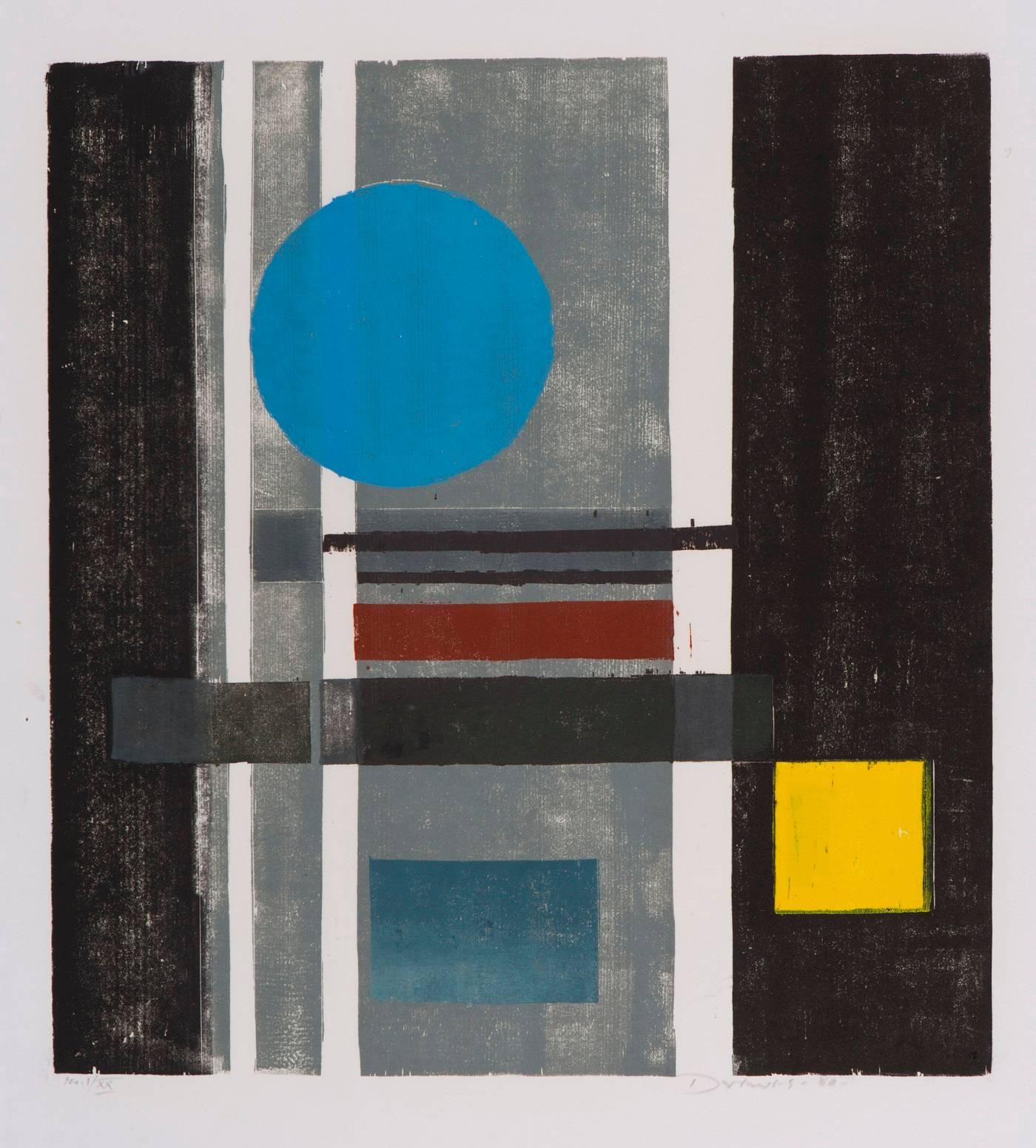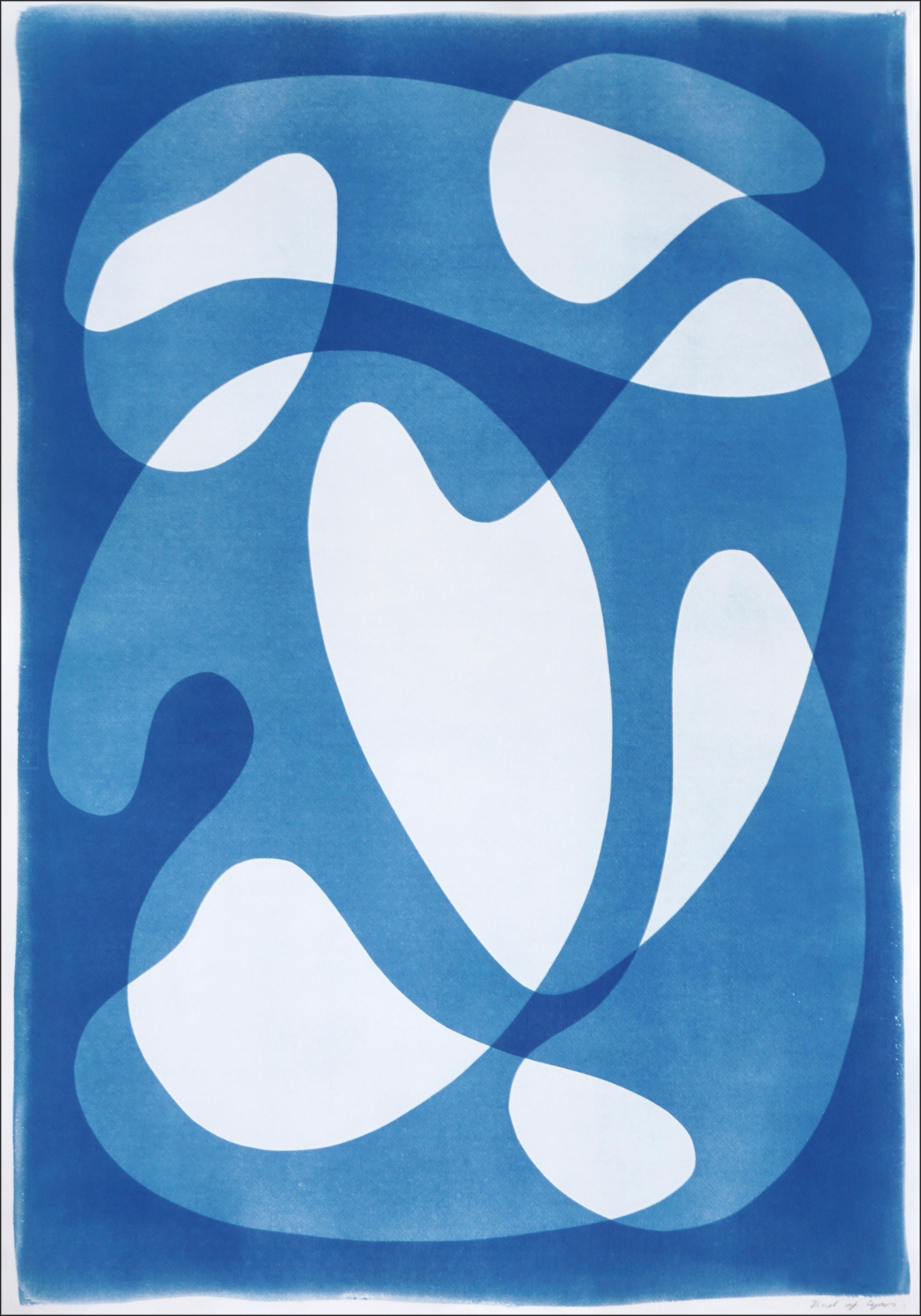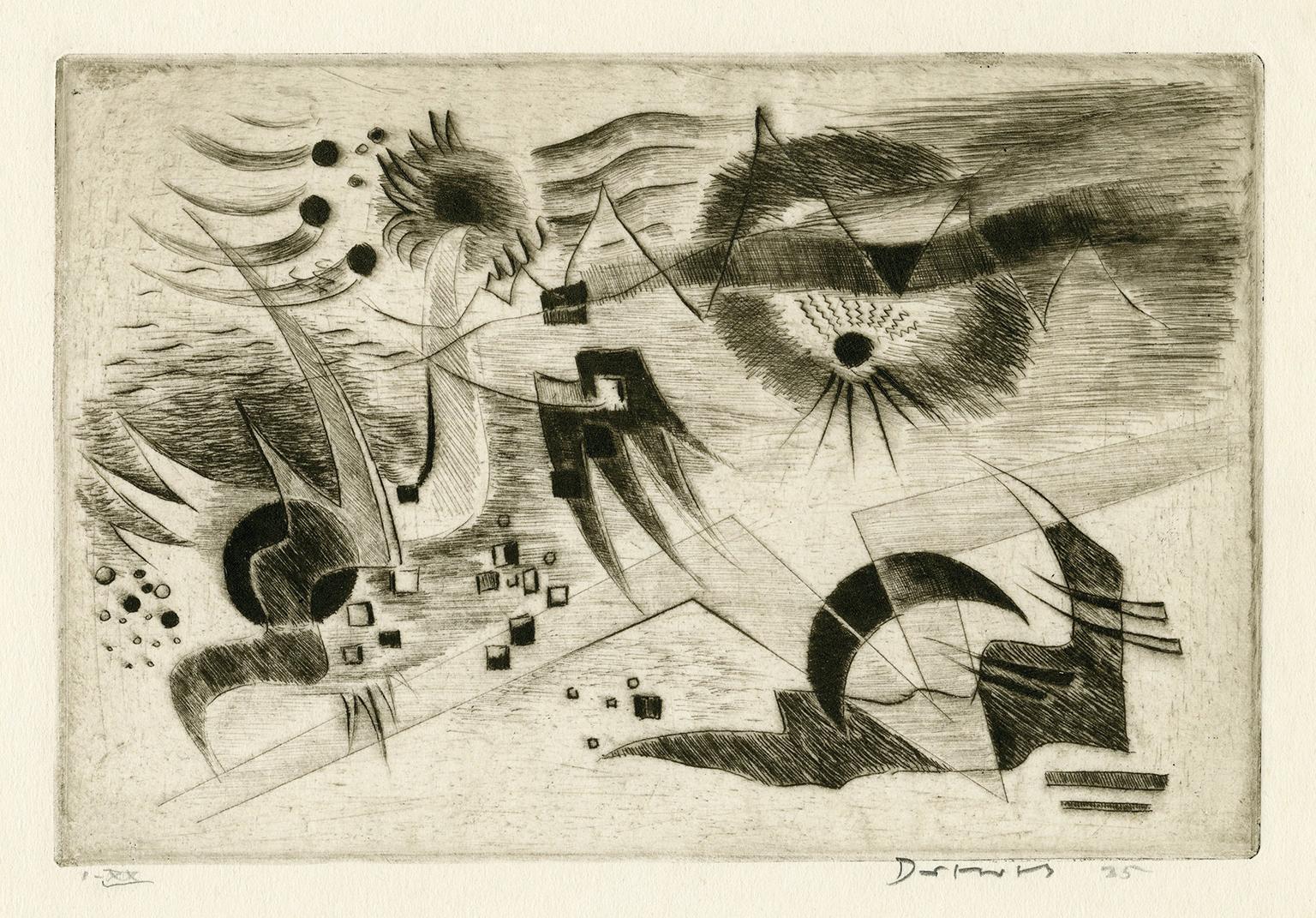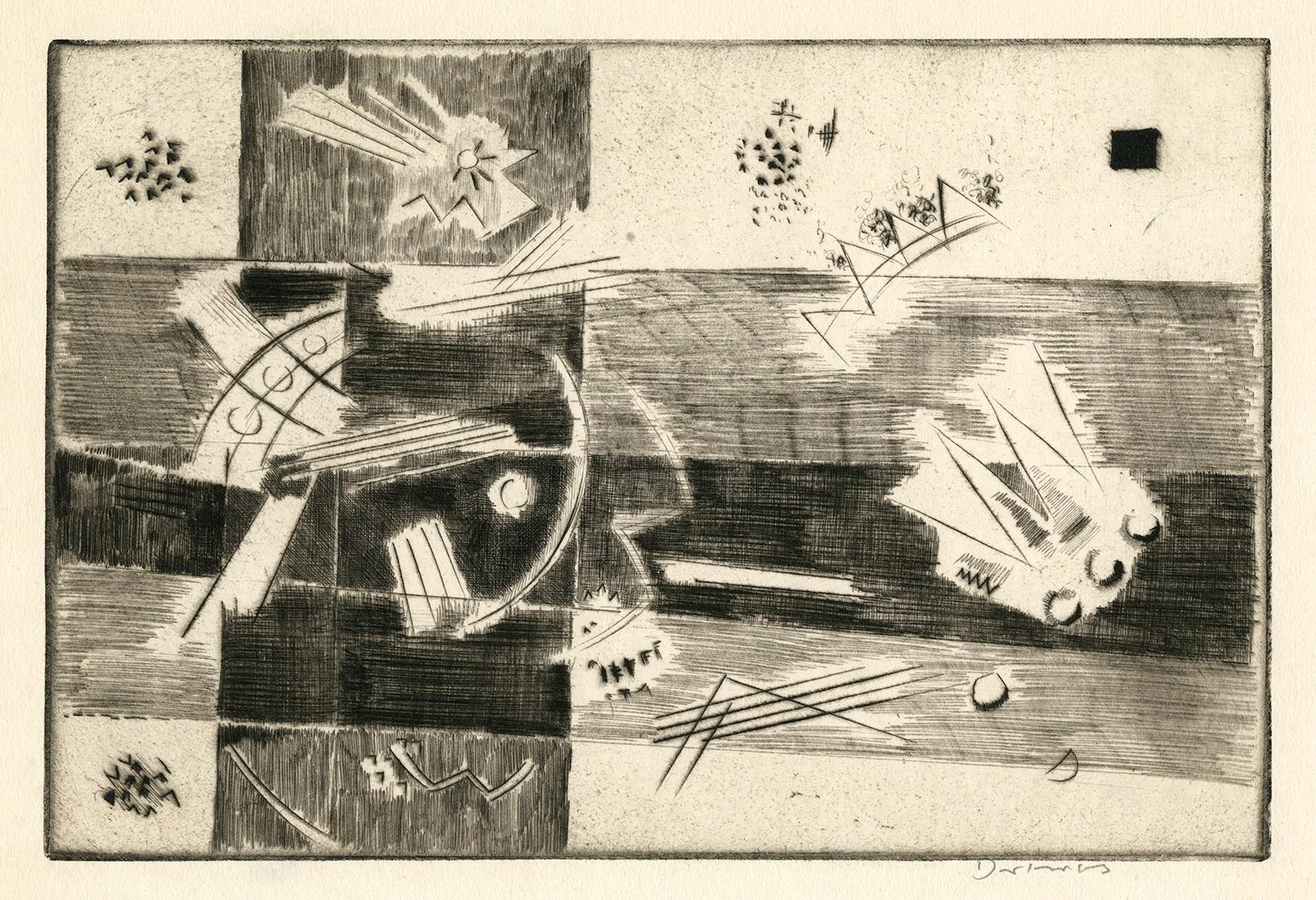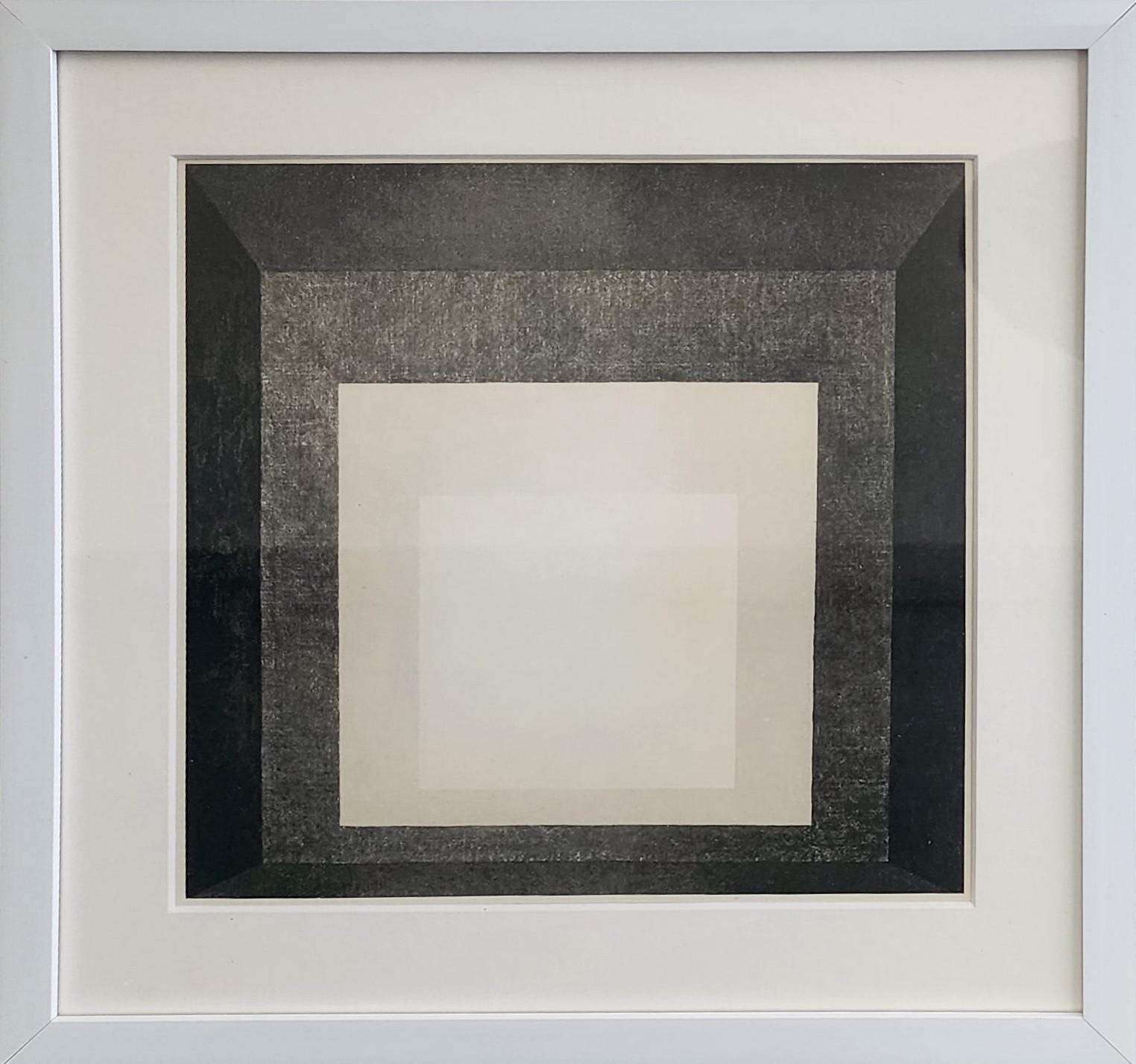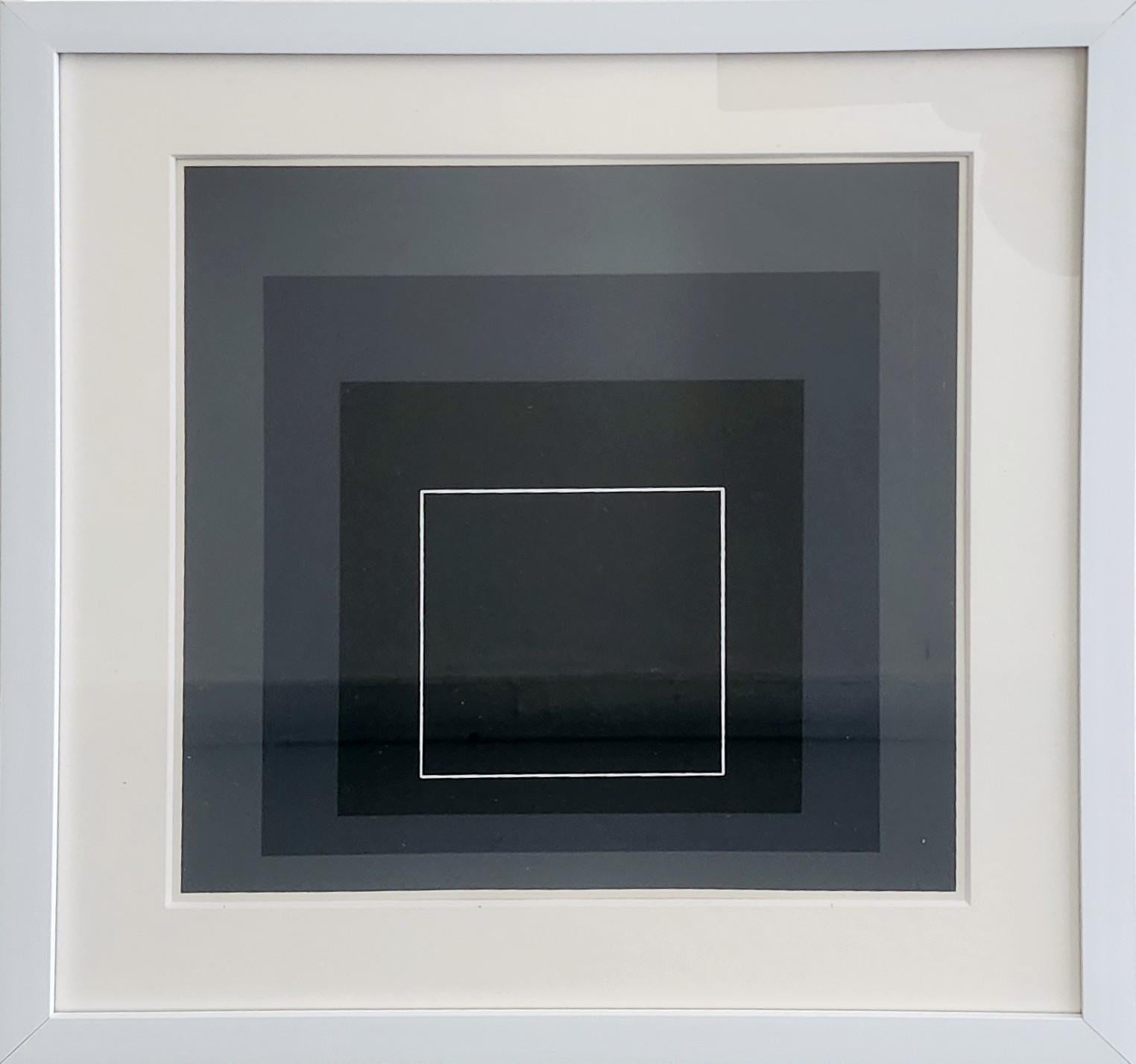Werner DrewesTwin Formation in Gray1982
1982
About the Item
- Creator:Werner Drewes (1899-1985, American)
- Creation Year:1982
- Dimensions:Height: 9.125 in (23.18 cm)Width: 17.875 in (45.41 cm)
- Medium:
- Movement & Style:
- Period:
- Condition:
- Gallery Location:Myrtle Beach, SC
- Reference Number:
Werner Drewes
Werner Drewes was a painter, printmaker, and teacher, who was born in Canig, Germany, in 1899. His father, a Lutheran Minister, hoped he would become an architect, but Werner chose the life of an artist. After he served on the front line in France during the war, Werner was admitted to the Bauhaus in 1921, where he studied under Klee, Itten, and Muche. Later, he traveled through Europe to study such old masters as Tintoretto, Velasquez and El Greco. After marrying Margaret Schrobsdorff, they traveled throughout South America, North America and Asia. In 1930, Werner immigrated to New York City with his family. In New York City, despite the Depression, Werner joined other Bauhaus artists such as Piet Mondrian and Lyonel Feininger to make a living as an artist. This group became the core of the American Abstract Artists group. Werner taught at Columbia University, worked on the design of the 1939 World's Fair building, and had shows at the Museum of Modern Art, Kleeman Gallery, and elsewhere. In 1946, he accepted a tenured position at the Washington University in St. Louis. In his later years, he moved to Virginia and continued to show at galleries in Germany, Turkey, and in the United States. The Smithsonian held a show attributing his 65 years as a printmaker at the Museum for American Artists.
- ShippingRetrieving quote...Ships From: Myrtle Beach, SC
- Return PolicyA return for this item may be initiated within 7 days of delivery.
- Pointed Shapes and Black Half MoonBy Werner DrewesLocated in Myrtle Beach, SCWerner Drewes, 'Pointed Shapes and Black Half Moon', etching, 1935, edition 20, Rose l.198. Signed, dated, and numbered 'I-XX' in pencil. A fine, rich impression, in warm black ink...Category
1930s Bauhaus Abstract Prints
MaterialsEtching
- Small Forms On Crossing BandsBy Werner DrewesLocated in Myrtle Beach, SCWerner Drewes, 'Small Forms on Crossing Bands', drypoint and roulette, 1935, edition 20, Rose 1.197. Signed in pencil. A fine, rich impression, in warm black ink, on cream wove paper...Category
1930s Bauhaus Abstract Prints
MaterialsDrypoint
- 'Signes' — Mid-Century Modernist AbstractionBy Jean (Hans) ArpLocated in Myrtle Beach, SCJean Arp, Signes, woodcut, edition 50, 1949. A fine, black impression, with all the fine lines printing clearly, on cream wove paper; the full sheet with wide margins (1 5/8 to 6 7/8 inches), in excellent condition. Signed and numbered '8/50' in pencil. Matted to museum standards, unframed. ABOUT THE ARTIST Jean Arp was born Hans Arp on September 16, 1886, in Strassburg. In 1904, after leaving the Ecole des Arts et Métiers, Strasbourg, he visited Paris and published his poetry for the first time. From 1905 to 1907, Arp studied at the Kunstschule, Weimar, and in 1908 went to Paris, where he attended the Académie Julian. In 1909, he moved to Switzerland and in 1911 was a founder of the Moderner Bund group there. The following year, he met Robert and Sonia Delaunay in Paris and Vasily Kandinsky in Munich. Arp participated in the Erste deutsche Herbstsalon in 1913 at the gallery Der Sturm, Berlin. After returning to Paris in 1914, he became acquainted with Guillaume Apollinaire, Max Jacob, Amadeo Modigliani, and Pablo Picasso. In 1915, he moved to Zurich, where he executed collages and tapestries, often in collaboration with his future wife Sophie Taeuber (who became known as Sophie Taeuber-Arp after they married in 1922). In 1916, Hugo Ball...Category
1940s Abstract Abstract Prints
MaterialsWoodcut
- 'Cheerleader' — Mid-century American SurrealismBy Robert Vale FaroLocated in Myrtle Beach, SCRobert Vale Faro, 'Cheerleader', wood engraving, 1945, edition 15. Signed, dated, titled, and numbered '104' (the artist's inventory number) and '8/15' in pencil. A fine, black impression, with full margins (1 1/2 inches), on heavy, cream wove paper, in excellent condition. Scarce. Matted to museum standards, unframed. ABOUT THE ARTIST Robert Vale Faro (1902-1988) was a well-known modernist architect and artist associated with the Chicago Bauhaus...Category
1940s Surrealist Abstract Prints
MaterialsWoodcut
- Still Life — Mid-century ModernBy Charles QuestLocated in Myrtle Beach, SCCharles Quest, 'Still Life', 1947, wood engraving, edition 8. Signed, dated, and numbered '3/8' in pencil. Titled and annotated 'wood engraving' in the bottom left margin. A fine impression, on off-white wove paper, with full margins (1 to 2 inches), in excellent condition. Scarce. Matted to museum standards, unframed. ABOUT THE ARTIST Charles Quest, painter, printmaker, and fine art instructor, worked in various mediums, including mosaic, stained glass, mural painting, and sculpture. Quest grew up in St. Louis, his talent evident as a teenager when he began copying the works of masters such as Michelangelo on his bedroom walls. He studied at the Washington University School of Fine Arts, where he later taught from 1944 to 1971. He traveled to Europe after his graduation in 1929 and studied at La Grande Chaumière and Academie Colarossi, Paris, continuing to draw inspiration from the works of the Old Masters. After returning to St. Louis, Quest received several commissions to paint murals in public buildings, schools, and churches, including one from Joseph Cardinal Ritter, to paint a replica of Velasquez's Crucifixion over the main altar of the Old Cathedral in St. Louis. Quest soon became interested in the woodcut medium, which he learned through his study of J. J. Lankes' A Woodcut Manual (1932) and Paul Landacre's articles in American Artist magazine ‘since no artists in St. Louis were working in wood’ at that time. Quest also revealed that for him, wood cutting and engraving were ‘more enjoyable than any other means of expression.’ In the late 1940s, his graphic works began attracting critical attention—several of his woodcuts won prizes and were acquired by major American and European museums. His wood engraving entitled ‘Lovers’ was included in the American Federation of Art's traveling print exhibition in 1947. Two years later, Quest's two prize-winning prints, ‘Still Life with Grindstone’ and ‘Break Forth into Singing’, were exhibited in major American museums in a traveling show organized by the Philadelphia Print Club. His work was included in the Chicago Art Institute's exhibition, ‘Woodcut Through Six Centuries’, and the print ‘Still Life with Vise’ was purchased by the Museum of Modern Art in New York. In 1951 he was invited by artist-Curator Jacob Kainen to exhibit thirty wood engravings and color woodcuts in a one-person show at the Smithsonian's National Museum (now known as the American History Museum). Kainen's press release praised the ‘technical refinement’ of Quest's work: ‘He obtains a great variety of textural effects through the use of the graver, and these dense or transparent grays are set off against whites or blacks to achieve sparkling results. His work has the handsome qualities characteristic of the craftsman and designer.’ At the time of the Smithsonian exhibition, Quest's work was represented by three New York galleries in addition to one in his home town. He had won 38 prizes, and his prints were in the collections of the Library of Congress, the Chicago Art Institute, the Metropolitan Museum, and the Philadelphia Museum of Art. In cooperation with the Art in Embassies program, his color woodcuts were displayed at the American Embassy in Paris in 1951. Recognition at home came in 1955 with his first solo exhibition in St. Louis. Press coverage of the show heralded the ‘growth of graphic arts toward rivaling painting and sculpture as a major independent medium’. An exhibition of his prints at the Bethesda Art Gallery in 1983 attracted Curator Emeritus Joseph A. Haller, S.J., who began purchasing his work for Georgetown University's collection. In 1990 Georgetown University Library's Special Collections Division was the recipient of a large body of Quest's work, including prints, drawings, paintings, sculpture, stained glass, and his archive of correspondence and professional memorabilia. These extensive holdings, including some 260 of his fine prints, provide a rich opportunity for further study and appreciation of this versatile and not-to-be-forgotten mid-Western American artist...Category
1940s American Modern Abstract Prints
MaterialsWoodcut
- Underwater — Mid-century ModernBy Charles QuestLocated in Myrtle Beach, SCCharles Quest, 'Underwater', 1948, chiaroscuro wood engraving, edition 12. Signed, titled, dated and numbered '3/12' in pencil. A fine, richly-inked impression, in dark brown and warm black, on off-white wove paper, with full margins (5/8 to 1 1/2 inch), in excellent condition. Scarce. ABOUT THE ARTIST Charles Quest, painter, printmaker, and fine art instructor, worked in various mediums, including mosaic, stained glass, mural painting, and sculpture. Quest grew up in St. Louis, his talent evident as a teenager when he began copying the works of masters such as Michelangelo on his bedroom walls. He studied at the Washington University School of Fine Arts, where he later taught from 1944 to 1971. He traveled to Europe after his graduation in 1929 and studied at La Grande Chaumière and Academie Colarossi, Paris, continuing to draw inspiration from the works of the Old Masters. After returning to St. Louis, Quest received several commissions to paint murals in public buildings, schools, and churches, including one from Joseph Cardinal Ritter, to paint a replica of Velasquez's Crucifixion over the main altar of the Old Cathedral in St. Louis. Quest soon became interested in the woodcut medium, which he learned through his study of J. J. Lankes' A Woodcut Manual (1932) and Paul Landacre's articles in American Artist magazine ‘since no artists in St. Louis were working in wood’ at that time. Quest also revealed that for him, wood cutting and engraving were ‘more enjoyable than any other means of expression.’ In the late 1940s, his graphic works began attracting critical attention—several of his woodcuts won prizes and were acquired by major American and European museums. His wood engraving entitled ‘Lovers’ was included in the American Federation of Art's traveling print exhibition in 1947. Two years later, Quest's two prize-winning prints, ‘Still Life with Grindstone’ and ‘Break Forth into Singing’, were exhibited in major American museums in a traveling show organized by the Philadelphia Print Club. His work was included in the Chicago Art Institute's exhibition, ‘Woodcut Through Six Centuries’, and the print ‘Still Life with Vise’ was purchased by the Museum of Modern Art in New York. In 1951 he was invited by artist-Curator Jacob Kainen to exhibit thirty wood engravings and color woodcuts in a one-person show at the Smithsonian's National Museum (now known as the American History Museum). Kainen's press release praised the ‘technical refinement’ of Quest's work: ‘He obtains a great variety of textural effects through the use of the graver, and these dense or transparent grays are set off against whites or blacks to achieve sparkling results. His work has the handsome qualities characteristic of the craftsman and designer.’ At the time of the Smithsonian exhibition, Quest's work was represented by three New York galleries in addition to one in his home town. He had won 38 prizes, and his prints were in the collections of the Library of Congress, the Chicago Art Institute, the Metropolitan Museum, and the Philadelphia Museum of Art. In cooperation with the Art in Embassies program, his color woodcuts were displayed at the American Embassy in Paris in 1951. Recognition at home came in 1955 with his first solo exhibition in St. Louis. Press coverage of the show heralded the ‘growth of graphic arts toward rivaling painting and sculpture as a major independent medium’. An exhibition of his prints at the Bethesda Art Gallery in 1983 attracted Curator Emeritus Joseph A. Haller, S.J., who began purchasing his work for Georgetown University's collection. In 1990 Georgetown University Library's Special Collections Division was the recipient of a large body of Quest's work, including prints, drawings, paintings, sculpture, stained glass, and his archive of correspondence and professional memorabilia. These extensive holdings, including some 260 of his fine prints, provide a rich opportunity for further study and appreciation of this versatile and not-to-be-forgotten mid-Western American artist...Category
1940s American Modern Abstract Prints
MaterialsWoodcut
- Circle and SquareBy Werner DrewesLocated in Boston, MAWerner Drewes. Circle and Square, 1980. Rose 386. Number 1 in an edition of 20. Signed and dated in pencil lower right margin: "Drewes -80-"; numbered in pencil lower left margin: "N...Category
20th Century Bauhaus Abstract Prints
MaterialsWoodcut
- Mid-Century Shapes IV, White and Blue Abstract Floating Shapes, Unique CyanotypeBy Kind of CyanLocated in Barcelona, ESThis is an exclusive handprinted unique cyanotype that takes its inspiration from the mid-century modern shapes. It's made by layering paper cutouts and different exposures using uv-...Category
2010s Bauhaus Abstract Prints
MaterialsPhotographic Film, Emulsion, Printer's Ink, Watercolor, Photographic Pap...
- Homage to the Square (Hommage au Carre) (Bauhaus, Geometric Abstraction)By (after) Josef AlbersLocated in Kansas City, MOJosef Albers Homage to the Square (Hommage au Carre) (Bauhaus, Geometric Abstraction) Screenprint in brilliant Colors on wove paper Year: 1972 From “Josef Albers: Son Oeuvre et Sa C...Category
1970s Bauhaus Prints and Multiples
MaterialsScreen
- Homage to the Square (Hommage au Carre) (Bauhaus, Geometric Abstraction)By (after) Josef AlbersLocated in Kansas City, MOJosef Albers Homage to the Square (Hommage au Carre) (Bauhaus, Geometric Abstraction) Screenprint in brilliant Colors on wove paper Year: 1972 From “Josef Albers: Son Oeuvre et Sa C...Category
1970s Bauhaus Prints and Multiples
MaterialsScreen
- Homage to the Square (Hommage au Carre) (Bauhaus, Geometric Abstraction)By (after) Josef AlbersLocated in Kansas City, MOJosef Albers Homage to the Square (Hommage au Carre) (Bauhaus, Geometric Abstraction) Screenprint in brilliant Colors on wove paper Year: 1972 From “Josef Albers: Son Oeuvre et Sa C...Category
1970s Bauhaus Prints and Multiples
MaterialsScreen
- Gewerbemuseum, Basel/Licht Reklame. 1928.By Charles Karl HidenlangLocated in New York, NYHindenlang, Charles [Karl]. Gewerbemuseum, Basel/Licht Reklame. 1928. Color lithograph. Printed by Wasserman, Basel. 35 1/5 x 50 1/4." Hiddenlang was known primarily as a muralist with interests in painting, glassware, ceramics, stage and graphic design. Born in Basel and educated at the city's Gewerbeschule. The Kunsthalle Basel dedicated to him in 1965 along with Dick and Karl Otto...Category
1920s Bauhaus Abstract Prints
MaterialsLithograph
